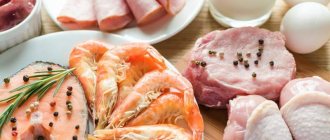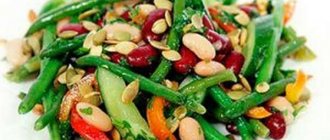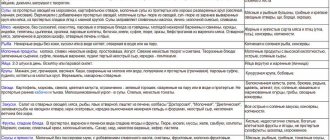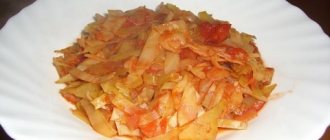One of the most common products that appears regularly on our table is meat. From time immemorial, meat dishes have been in demand and have been an integral part of the human diet. Among the varieties of meat known today, pork and beef have been especially popular, but recently there has been an increasing demand for lamb, which takes its place in the meat line. It's all about its beneficial properties, which distinguish lamb from other types of meat, as well as the dietary value of this meat. Thus, by replacing fatty and heavy pork with easily digestible lamb, you can solve a number of health problems and normalize your weight. So that you have no doubt about the benefits of lamb, let’s consider its main features and distinctive properties.
What is lamb
Lamb is the meat of animals (lambs and lambs) that were slaughtered between the ages of three months and one year. At this age, their meat is pale red, pale pink, tender, the fat is light, and separates well. The meat of old animals is dark, tough, has an unpleasant smell and taste and is not suitable for food. In terms of calorie content, lamb is in second place after pork. In addition, even young lamb has its own specific smell and taste, which not everyone likes. Therefore, to get rid of it, fat is removed from lamb and marinated in various spices.
Lamb: benefits
The benefit of lamb is that it contains a lot of protein, vitamins, and microelements. Lamb is rich in B vitamins, such as B1, B2, B3, B5, B6, B12, as well as fat-soluble vitamins D and E, vitamin K. Of the microelements, it is worth noting iron, which is found in lamb more than in any other meat. Therefore, people suffering from anemia should include this type of meat in their diet. It also contains elements such as phosphorus, fluorine, calcium, magnesium, potassium, manganese, and zinc.
A large amount of B vitamins improves the function of the nervous system, normalizes its functioning, and prevents various nervous disorders.
Lamb has a positive effect on the functioning of the pancreas and can protect against such a dangerous disease as diabetes.
Meat broths prepared with lamb can be recommended for people suffering from hypoacid gastritis.
It is also important to pay attention to the use of lamb fat for the treatment of various types of respiratory diseases. For coughs and bronchitis, traditional medicine recommends consuming fat with warm milk (1 teaspoon per glass of milk).
To sum it all up, we can conclude that lamb is a very useful product that has a positive effect on the functioning of organs and the general condition of the body, and also helps prevent or reduce the risk of a number of diseases.
Chemical composition of meat
The chemical composition of meat is varied. Lamb contains B vitamins, which have a beneficial effect on metabolism. Animal meat also contains vitamins K, D and E, which stimulate the circulatory system, strengthen bones and improve immunity.
It is recommended to eat lamb to prevent rickets and autoimmune diseases.
The mineral composition of meat is rich and varied: magnesium, calcium, sodium, phosphorus, potassium and iron - all this is contained in lamb. The presence of iron increases hemoglobin, and in combination with B vitamins, the substance is well absorbed. Potassium improves the functioning of the cardiovascular system.
The following table lists all the vitamins, as well as micro- and macroelements contained in meat. All data are given per 100 g.
Lamb: harm
Having considered the beneficial properties of lamb, one cannot help but warn that lamb can harm the body, especially if you eat a lot of it. There are a number of points when it is worth limiting your lamb consumption or giving up this type of meat altogether.
People who suffer from gastrointestinal diseases such as hyperacid gastritis, stomach and duodenal ulcers, liver and gallbladder diseases should not eat lamb. This meat is not recommended for kidney disease.
Women who are breastfeeding should also avoid lamb, as this can have a negative impact on the baby’s imperfect digestive system. Also, this meat should not be used as complementary food for small children. In general, it is better to exclude lamb from the diet of both children and the elderly.
The harm of lamb for people suffering from gout and arthritis of the joints is that it can cause an exacerbation of these diseases.
Cardiovascular diseases may also be a reason to avoid eating this food product.
Is it possible to eat lamb on a diet?
Meat is one of the food products that a person needs for the normal functioning of the body. It is the main source of proteins that go into building our body. The most consumed meat is pork, beef, and poultry. But recently (with the growing popularity of Caucasian cuisine) the share of lamb consumption has been increasing. At the same time, the question arises: what are the benefits and harms of this meat, how often and who can eat it.
Lamb is the meat of animals (lambs and lambs) that were slaughtered between the ages of three months and one year. At this age, their meat is pale red, pale pink, tender, the fat is light, and separates well. The meat of old animals is dark, tough, has an unpleasant smell and taste and is not suitable for food. In terms of calorie content, lamb is in second place after pork. In addition, even young lamb has its own specific smell and taste, which not everyone likes. Therefore, to get rid of it, fat is removed from lamb and marinated in various spices.
The benefit of lamb is that it contains a lot of protein, vitamins, and microelements. Lamb is rich in B vitamins, such as B1, B2, B3, B5, B6, B12, as well as fat-soluble vitamins D and E, vitamin K. Of the microelements, it is worth noting iron, which is found in lamb more than in any other meat. Therefore, people suffering from anemia should include this type of meat in their diet. It also contains elements such as phosphorus, fluorine, calcium, magnesium, potassium, manganese, and zinc.
A large amount of B vitamins improves the function of the nervous system, normalizes its functioning, and prevents various nervous disorders.
Lamb has a positive effect on the functioning of the pancreas and can protect against such a dangerous disease as diabetes.
Meat broths prepared with lamb can be recommended for people suffering from hypoacid gastritis.
It is also important to pay attention to the use of lamb fat for the treatment of various types of respiratory diseases. For coughs and bronchitis, traditional medicine recommends consuming fat with warm milk (1 teaspoon per glass of milk).
To sum it all up, we can conclude that lamb is a very useful product that has a positive effect on the functioning of organs and the general condition of the body, and also helps prevent or reduce the risk of a number of diseases.
Having considered the beneficial properties of lamb, one cannot help but warn that lamb can harm the body, especially if you eat a lot of it. There are a number of points when it is worth limiting your lamb consumption or giving up this type of meat altogether.
People who suffer from gastrointestinal diseases such as hyperacid gastritis, stomach and duodenal ulcers, liver and gallbladder diseases should not eat lamb. This meat is not recommended for kidney disease.
Women who are breastfeeding should also avoid lamb, as this can have a negative impact on the baby’s imperfect digestive system. Also, this meat should not be used as complementary food for small children. In general, it is better to exclude lamb from the diet of both children and the elderly.
The harm of lamb for people suffering from gout and arthritis of the joints is that it can cause an exacerbation of these diseases.
Cardiovascular diseases may also be a reason to avoid eating this food product.
There is no so-called “lamb diet”. Lamb cannot be consumed during a diet, given its high calorie content and possible harmful effects on the body.
However, it is known that in order to get rid of excess weight, it is not effective to exhaust the body on strict diets, but to reduce the caloric content of the diet. That is, simply replace your favorite foods with their diet version.
So is it possible to eat lamb on a diet? It is possible and necessary. Just choose meat from the back of the carcass, which contains less fat and calories. The way the meat is cooked is also very important. It is best if you cook the lamb, in extreme cases, bake it in the oven, but under no circumstances fry it. When frying meat, additional fats are used, and the calorie content of the product almost doubles. And if you decide to lose weight, then you don’t need extra calories at all.
You should not eat only lamb from meat products; use other types of meat in your diet. In lamb, as in all products, there is a deficiency of some substances and an excess of others, which can upset the balance of micro- and macroelements in the body and harm health.
Use these simple tips and you will see your weight return to normal in no time.
Based on materials from webdiana.ru
Anna Belousova is a famous Russian practicing nutritionist, member of the international team of developers of popular weight loss products Modelform
invites her to understand the myths about lamb and why it is not necessary to exclude this meat from your diet.
When a nutritionist tells his patients that they can also eat lamb, among other types of meat, in most cases they are perplexed: “How? It’s too greasy, heavy, and smells!” Meanwhile, lamb is a very healthy and tasty meat, which greatly helps to diversify the diet during a diet.
So, let's immediately deal with the issue of fat content and calorie content. Fatty lamb contains 16.3% fat, lean lamb contains 9.6%, which corresponds to 209 or 166 kcal per 100 g. Let us consider for comparison beef, which contains 16% fat in fatty meat, 9.8% in lean meat, and In terms of calorie content, beef is even ahead of lamb, albeit slightly: 218 or 168 kcal per 100 g, depending on the category. Lamb remains far behind when compared in terms of fat content with turkey, broiler chicken, not to mention sausages and mayonnaise.
And yet, lamb fat has its own peculiarity. It is more refractory, that is, it breaks down at a higher temperature than beef or pork fat. Although, a temperature of 37 0 C or slightly higher, which is typical for our digestive system, is quite enough for lamb fat. The main thing is that lamb dishes should not be washed down with very cold drinks.
The opinion about the “heaviness” of lamb is also a little erroneous: the protein of this meat is digested no worse than others. But the refractoriness of fat matters. People with liver, pancreas, or gallbladder disease may not tolerate lamb well. Although, its tolerance greatly depends on the method of cooking the meat.
In fact, the opinion about the fat content and heaviness of lamb is more subjective. Where do we most often encounter this meat? That's right, in the national cuisines of Central Asia, China, and the Caucasus. For example, pilaf simply cannot be low-fat, otherwise it is no longer pilaf! Traditional lamb in a frying pan in Chinese restaurants is prepared with the obligatory addition of pork, goose or duck fat and starch. And in the Caucasus, even fatty lamb is excellently cooked over coals, but usually they serve it with so much greenery and vegetables that the fat simply does not have time to be absorbed!
Just let's not forget that lamb is actively present in the cooking of other countries. It is readily eaten in Italy and Spain, Turkey and Greece (by the way, food in the Mediterranean countries is considered one of the healthiest), in Albania and Bulgaria, Hungary, Australia and the UK. Where does this worldwide prevalence come from? Everything is very simple: in those times when peoples led a nomadic or semi-sedentary lifestyle, it was flocks of sheep that accompanied them. There are numerous references to this even in the Old Testament. By the way, sheep farmers joke that you can never drive a cow or a pig like sheep. Therefore, our lambs are fitness enthusiasts.
And, if we touch on the field of livestock farming, then we need to mention one more important point. Sheep and rams are much more difficult to feed with combined food than other animals; they prefer natural food. And, therefore, the meat is more environmentally friendly.
In terms of the content of protein, vitamins and minerals, lamb is not inferior, but not much ahead of other types of meat.
Another important fact that requires discussion is the smell of lamb. In fact, all types of meat differ in smell from each other. A person with a good sense of smell will never confuse the smell of raw pork, beef, lamb, chicken or rabbit, even blindfolded. If, of course, the meat is fresh. So, lamb is the meat that stays fresh the longest, even in the heat. According to one legend, the choice of the capital of present-day Uzbekistan depended on lamb during the time of Tamerlane. The formidable ruler ordered that a lamb be slaughtered and skinned in each of the cities and monitor where the carcass would remain fresh longer. The choice fell on Samarkand.
It was in Uzbekistan that I was taught how to choose and cut lamb correctly. Of course, I am far from the chefs there, but I will share my knowledge!
If you really want to “make friends” with lamb, go to the market or farm store to buy meat, where you will be offered not just chopped pieces, but will be given a look at the whole carcass, or at least its large parts. This is where the smell problem is solved! The fact is that sheep farmers know many breeds of lamb, but culinary specialists distinguish only two features: fat-tailed and non-tail-tailed lamb. Non-fat-tailed lamb actually has a sharper smell, which many people don’t like. In addition, instead of it, they may well sell you goat meat, which is much cheaper (but this will not be reflected in the price tag, of course). In principle, goat meat is also quite edible meat, but it actually has a specific smell.
In general, look for fat-tailed lamb. Fat tail is an accumulation of fat around the tail, sometimes quite abundant, which makes fat-tailed lambs and sheep look like a lady dressed in a dress with a bustle. In the markets, they usually hang half a carcass or a hind leg with a tail, so that it can be seen that the lamb is correct. The total percentage of fat content of such lamb is slightly higher, precisely because of the presence of the fat tail, but don’t let this scare you - we will not take either the fat tail or the hind leg! Ask the seller to separate the front leg or shoulder blade from the same carcass: there is very little fat in it. Smell, press with your finger, assessing the depth of the hole, thereby checking the meat for freshness. Good fresh lamb has a not pungent smell, just a little sweet.
And then they will offer you to chop the piece into smaller pieces, so, under no circumstances agree! Otherwise, you will have to wash the lamb before further cutting, and less experienced housewives should not do this. It’s better to tinker a little yourself, but then the meat will be more dietary. I can imagine how after these lines real cooks from Central Asia and experienced butchers will curse me, but believe me, we simply have different tasks. For the chef it is important to cook tasty and “correctly”, for us it is as low in calories as possible. So we proceed to further cutting the meat “dry”; in extreme cases, you can remove external contamination with a paper towel. The fact is that all visible fat is separated from lamb that has not been pre-washed much easier than from other types of meat. It is best to do this with your hands, but you can also help yourself with a knife. When all the external fat has been removed, the piece can be thoroughly washed with cool water, dried with a paper towel, allowed to air dry a little more so that your hands do not slip, and then cut further into pieces convenient for your culinary purposes.
Well, what kind of lamb dishes does the world culinary offer us, read in the “Healthy Recipes” section on the modelform
. ru
!
Be healthy, beautiful and happy! Your Anna Belousova, nutritionist, member of the international team of developers of popular weight loss products Modelform .
Based on materials from lab-krasoty.ru
National Caucasian cuisine is represented by various lamb dishes. Lamb is distributed throughout Europe. Young lamb meat is considered dietary. Therefore, it is often included in the diet when following a therapeutic diet. An adult ram is not low in calories, but its taste is not inferior to a young one. In addition, this type of meat is very beneficial for the human body. Lamb has a specific aroma. Because of this, not everyone likes meat. But everyone needs to try it at least once.
Many people believe that lamb is the meat of a mature sheep. In fact, only young lamb product is used for cooking. The maximum age allowed is 1 year. Already sexually mature male rams are not used for cooking. They have an unpleasant odor and taste that is very difficult to get rid of. Therefore, lamb meat is very healthy.
The product is considered a source of many vitamins. Thus, vitamin group B has a high concentration - B1, B2, B3, B5, B6, B9, B12. Vitamin B12 is famous for its high levels. 100 grams of lamb meat contains 70% of the daily requirement of this vitamin. The product also contains vitamins E, H, PP, K.
No less impressive mineral composition of the animal carcass:
The benefit of the product lies in the fact that it is a source of most essential acids. The human body does not produce these acids on its own. Therefore, it is very important to receive them from outside. Lamb will fill their deficit.
Many people know that meat is prohibited in the diet. The only exception is poultry meat. But this has nothing to do with lamb. Young lamb does not contain carbohydrates. Therefore, the product can be eaten during weight loss diets and diabetes. As for calorie content, it is 150 kcal per 100 grams of meat. This is very little, especially in comparison with fatty and high-calorie pork meat.
Moreover, lamb contains a record low amount of fat - 20 grams. This is two times lower than pork. Speaking of proteins, there is quite a bit of them in the product (17 grams), and they are easily digestible. Consequently, the body quickly becomes saturated, heaviness in the stomach and intestinal disorders do not occur. Therefore, a high-quality young carcass cooked without frying in oil is an excellent dietary dish.
How is lamb beneficial for people? B vitamins improve a person's overall well-being. When they are deficient, increased fatigue, irritability, and decreased ability to work occur. By increasing tone, the body is charged with energy and strength. It is also recommended to use the product to strengthen the immune system. Lamb is recommended for consumption to normalize blood circulation.
The animal fat of this product is not high. Many people think that lamb is a source of cholesterol. This is wrong. High-quality lamb meat does not contain harmful cholesterol. And the rich chemical composition helps reduce cholesterol in human blood. Normalizing blood circulation reduces blood pressure. Therefore, such food is recommended for hypertensive patients. Also, lamb improves heart function, prevents the development of atherosclerosis, and strengthens the walls of blood vessels.
Lecithin, which is part of the product, restores the functions of the digestive system. It is very useful to use lamb-based broths for people suffering from stomach ulcers and gastritis. But it is worth noting that this diet is suitable for those who have low stomach acidity. If the acidity is high, meat broths and the meat itself are prohibited for consumption.
High levels of fluoride and calcium are very beneficial for the body's skeletal system. Doctors advise elderly people and children to eat lamb. Thus, a mature person will protect himself from the development of osteoporosis, arthritis, and arthrosis. The benefit for the child is the full development of the skeletal and muscular systems. By regularly consuming the product, tooth enamel is strengthened. The meat of this animal is an excellent prevention of caries.
Pregnant women are advised to eat lamb dishes. The fact is that a sufficient amount of folic acid (vitamin B9) strengthens a woman’s immune and nervous systems. Moreover, folic acid is necessary for the fetus for the formation and development of the central nervous system. A deficiency of this component leads to congenital pathologies of the baby’s development.
The large amount of iron in lamb allows it to be used to prevent anemia. Also, the product helps increase hemoglobin levels in the blood. The product against colds is very useful for children. Animal fat is used for treatment. Compresses and infusions are prepared on its basis. Sometimes it’s enough just to rub the baby’s body with animal fat and wrap him in a warm blanket.
The absence of carbohydrates in the carcass has a positive effect on the condition of the pancreas and reduces the risk of developing diabetes. Lamb is the best prevention of hereditary type 2 diabetes. A large number of vitamins and minerals provide the following benefits:
- Accelerate metabolism;
- Renew metabolic processes;
- Promote the regeneration of brain cells;
- Helps you lose weight.
To get rid of extra pounds, you need to reduce the amount of calories and carbohydrates. Such nutrition, in combination with physical activity, will contribute to the transformation of adipose tissue into muscle. Many people mistakenly believe that meat should be excluded from their diet. You cannot completely give up animal fats. The body must receive them, albeit in minimal quantities.
Therefore, to lose weight, fatty meats need to be replaced with young lamb. It will saturate the body with all the necessary minerals and vitamins. To quickly lose weight, it is better to eat meat cut from the back of a sheep. This part has a minimum amount of fat and a maximum level of useful components.
It is important to properly cook lamb for weight loss. Frying meat is strictly prohibited. During the diet, any food needs to be boiled or steamed. It is permissible to bake meat in the oven. But during the cooking process, the product almost completely loses calories and cholesterol. At the same time, boiled lamb is very tender and tasty. Also, the product can be used to prepare broths.
Your health depends on the correct choice of product. It is very important to choose the right lamb. A low-quality product can cause digestive system disorders and poisoning. In addition, the carcass of an old sheep is very tough and has an unpleasant odor. First of all, pay attention to the color of the product. A fresh, good carcass has a red and pink color. This is the color characteristic of a young lamb. A young lamb has small layers of fat. The fat should be white. If it is yellow, it means the animal is already old.
When choosing a product, you can be guided by the following recommendations:
- Young lamb has only white fat;
- The color of the meat should be the same, uniform;
- A high-quality young carcass has elastic meat;
- The aroma of a good lamb is rich and pleasant, without a specific smell;
- The consistency of the product should only be coarse-grained;
- The skeletal system of a high-quality carcass is white;
- The surface of the meat should be moist.
The less fat is observed on the lamb, the younger it is. Also, the age of a ram can be determined by the condition of the ribs. The greater the distance, the gaps between the bones of the ribs, the older the ram was. Guided by these tips, there will be no problems with choosing quality products.
Based on materials from foodsinfo.ru
Lamb is considered a dietary product and is much more suitable for some people than pork. There are really many benefits from such meat, and to be convinced of this, it is enough to study its composition and learn more about the beneficial effects on the body.
The calorie content of meat is determined by its category (the level of fatness of the animal), which, in turn, determines whether it is fatty or not. Thus, 100 g of lamb of the first category contains about 210 kcal, while the same amount of meat of the second category contains only 166 kcal. At the same time, despite the lower energy value, the latter option includes 1.5 times more useful components.
For lamb of the first category (100 g) the following values are typical:
- vitamin B1 - 0.08 mg;
- vitamin B2 - 0.14 mg;
- RR - 3.80 mg;
- potassium - 270.00 mg;
- phosphorus - 168.00 mg;
- sodium - 80.00 mg;
- calcium - 9.00 mg.
For comparison, in 100 g of lamb of the second category, the number of components will be slightly different:
- vitamin B1 - 0.09 mg;
- vitamin B2 - 0.16 mg;
- RR - 4.10 mg;
- potassium - 345.00 mg;
- phosphorus - 190.00 mg;
- sodium - 101.00 mg;
- calcium - 11.00 mg.
Other mineral components include iron, iodine, cobalt, manganese, copper, molybdenum, sulfur, phosphorus, chlorine, choline, zinc and chromium, and useful vitamins also include vitamins E, K, D, B5, B6, B9 , AT 12.

The benefits of dietary lamb meat are equally noticeable in relation to both the female and male bodies, each of which has its own nuances of such an effect.
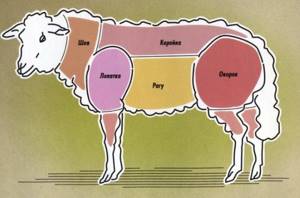
The constituent components of lamb have a complex positive effect on the human body, but as for male representatives, the most significant for them will be the following beneficial properties of such meat:
- increased resistance to stress and improved morale (it is no secret that by holding back emotions, men suffer more from hidden depression);
- increased potency and increased sexual desire;
- improving sleep quality and combating insomnia;
- strengthening bone tissue;
- improving the digestibility of protein foods and its uniform distribution throughout the body (especially important for athletes);
- increasing testosterone production.
The benefits of lamb for the female body are no less significant than for the male body, and, first of all, are expressed in:
- improving the appearance of skin, teeth and hair, which is largely due to the presence of fluoride in the composition;
- supporting the body's immune system;
- acceleration of metabolic processes (due to this, weight loss occurs);
- preventing anemia (with regular consumption of lamb, young girls can avoid dizziness during menstruation);
- a large amount of folic acid, which will be appropriate during pregnancy, having a positive effect on the development of the fetus.
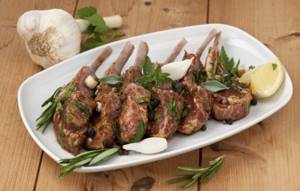
In addition to this, vitamins E and K strengthen the skeleton well and participate in hematopoietic processes, while simultaneously improving the overall well-being of a woman. Such properties of lamb are especially noticeable when health deteriorates or during certain periods of a woman’s life. Despite the significant benefits of lamb meat, it is not suitable for regular consumption by everyone. Moreover, the amount of product eaten can also negatively affect overall well-being, therefore, when choosing lamb, it is worth knowing about its impact on different categories of consumers.
The nutrition of a pregnant woman or young mother should always be selected taking into account the interests of her child. In general, the dietary properties of lamb make it a suitable product in any of these cases, since such meat is quickly digested, does not cause a feeling of heaviness and will not ferment in the intestines, causing discomfort in a woman and a newborn baby.

At the same time, folic acid, which is part of meat, is simply irreplaceable for pregnant women, and during breastfeeding, the vitamins and minerals included in the composition enhance milk production.
There is much less fat in lamb than protein, so it can be safely included in the diet of people who are overweight or simply watching their figure. The product’s ability to speed up metabolism is a very valuable “skill” when losing weight; moreover, such meat contains practically no cholesterol, which can provoke the development of atherosclerosis.
Simply put, lamb will be equally beneficial for people on a diet and for those who are prone to cholesterol accumulation.

The possibility of eating lamb meat for pancreatitis depends on the form of the disease. In case of acute development of the disease, it is recommended to completely exclude such a product from the patient’s menu, while the chronic course of the disease allows the possibility of its use, but in limited quantities (in the phase of stable remission, no more than 100–200 g of boiled or baked product). The main thing is to choose pieces with the least amount of fat, because it is this that can aggravate the situation in case of pancreatitis. The best meat in this regard is considered to be meat from dairy lambs or rams under 3 years of age.
There are two opposing opinions about the possibility of eating lamb for arthritis and gout. Some experts do not advise patients to consume it because of the purines (nitrogen-containing chemical compounds) present in the composition, while others consider this type of meat to be the best alternative to pork and beef.
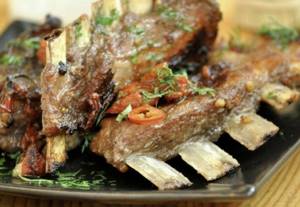
To minimize the effect of purines on the patient’s body, it is advisable to choose only lean pieces obtained from young animals, avoiding the consumption of offal (liver, kidneys, lungs). However, this recommendation does not apply to situations of exacerbation of the disease, because it is better to discuss the diet during treatment with your doctor.
Lean lamb is an ideal solution for meat nutrition for people suffering from diabetes. It is able to control the secretion of gastric juice, thereby facilitating the work of the pancreas, and young lamb meat additionally promotes the outflow of bile and improves liver function. In addition, such a product is an excellent prevention of the development of diabetes, since it contains lecithin.
Unfortunately, with all its positive properties, lamb meat cannot be called completely harmless. The main contraindications to its use include:
- liver and kidney diseases;
- ailments of the gastrointestinal tract, accompanied by increased stomach acidity (meat components can increase it even more);
- hemorrhagic colitis of various nature;
- gallbladder dysfunction;
- cholelithiasis;
- gout and joint diseases (depending on the stage).
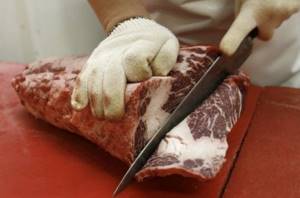
Of course, you shouldn’t overuse lamb even if you feel well, because an excessive amount of any meat can worsen digestive processes and cause a feeling of heaviness in the stomach.
Lamb is excellent for preparing a wide variety of dishes - both for the first and for the second. It also makes a good kebab, but for these purposes it is better to choose pieces with a layer of fat. Popular dishes using this type of meat include:
- baked lamb with major;
- leg of lamb with herbs;
- canakhi with lamb;
- shurpa (first course);
- bouillon;
- aspic;
- lamb stew;
- stewed lamb ribs.

If desired, you can stuff a leg of lamb, prepare goulash or meatloaf. In short, lamb meat can be used to implement almost any culinary idea.
Despite the fact that in the nuances of cooking, lamb is often equated to pork or beef, it also has some specific processing features, knowledge of which will help you obtain a very tasty and aromatic dish.
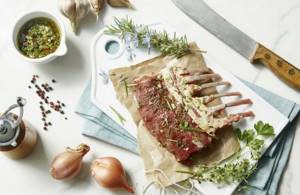
The main secrets of cooking lamb include the following points:
- for preparing stewed or boiled dishes, it is better to purchase a neck or shank;
- delicious baked or fried meat is obtained from the upper part of the shoulder, shank or loin, and when frying it is worth placing them with the fatty part down;
- The ham is considered a universal part for stewing, frying or baking, although the brisket can also be used for stuffing;
- if you are buying lamb for the first time, then choose the meat of young lambs, since it is much more difficult to make mistakes in the nuances of its preparation;
- to enhance the taste properties of meat, it is worth using all kinds of marinades, especially since lamb absorbs them well;
- It is advisable not to rinse the purchased piece under running water, but simply wipe it with a paper towel and remove tendons and films (they are not edible);
- If there is an unpleasant odor coming from the meat, soaking it in vodka or adding cinnamon during the cooking process will help get rid of it;
- Fresh meat can only be stored in the refrigerator, at temperatures up to +5 °C, and it is advisable to freeze only steamed meat.
Video: How to cook lamb In general, lamb can safely be called one of the most ideal products in the kitchen with an optimal set of beneficial properties. However, in order for meat to truly bring only benefits, it is important to take into account many additional factors, in particular, the health characteristics of consumers and the nuances of preparing dishes.
Based on materials from lifegid.com
Is it possible to eat while losing weight?
There is no so-called “lamb diet”. Lamb cannot be consumed during a diet, given its high calorie content and possible harmful effects on the body.
However, it is known that in order to get rid of excess weight, it is not effective to exhaust the body on strict diets, but to reduce the caloric content of the diet. That is, simply replace your favorite foods with their diet version.
So is it possible to eat lamb on a diet? It is possible and necessary. Just choose meat from the back of the carcass, which contains less fat and calories. The way the meat is cooked is also very important. It is best if you cook the lamb, in extreme cases, bake it in the oven, but under no circumstances fry it. When frying meat, additional fats are used, and the calorie content of the product almost doubles. And if you decide to lose weight, then you don’t need extra calories at all.
You should not eat only lamb from meat products; use other types of meat in your diet. In lamb, as in all products, there is a deficiency of some substances and an excess of others, which can upset the balance of micro- and macroelements in the body and harm health.
Use these simple tips and you will see your weight return to normal in no time.
How to cook meat for those who want to lose weight?
First of all, when eating on a diet, you need to avoid frying in vegetable oil, grilling and battering.
These are the most high-calorie cooking methods that can increase the calorie content of even the most dietary meat. The best options for processing meat dishes are boiling and stewing.
With this processing method, beneficial substances are preserved, and calories do not increase. Baking with a vegetable side dish and steaming are considered acceptable.
If you cannot give up the usual frying of meat products, it is recommended to fry in a dry frying pan without using oil.
In the oven
Baking in the oven allows you to cook tasty and juicy meat, preserving all its beneficial properties. This method is simple and does not require much time.
You can simplify the cooking process and avoid burning by using baking foil. The advantage of this method is the preservation of the juiciness and softness of the dish, which is quite difficult to achieve when frying or stewing.
For a couple
Typically, a kitchen appliance such as a slow cooker is used to steam low-fat meat. It allows you to prepare a dish quickly and without problems; the steam preserves the maximum amount of proteins and vitamins.
The advantage of this method is its simplicity, because food can be left in the multicooker even unattended: the automatic timer will not allow them to burn or overcook.
Boiled
Boiling allows you to prepare a lean dish with easily digestible protein, but not all types of meat are suitable for this method. It is better to cook chicken, turkey, and rabbit.
You should avoid boiled pork: it has a specific smell.
Main types and varieties
Meat from rams and sheep is used as table meat and for processing into smoked/canned meats. The meat of adult sheep/rams is red, that of young sheep is pink, and that of “elderly” sheep is dark red. Lamb also has a rather specific smell, which can be eliminated with the help of spices and simple manipulations.
Classification of lamb according to carcass fatness:
- Category 1 : satisfactorily developed muscles, a thin layer of subcutaneous fat along the back and lower back, gaps in the sacrum, pelvis, and ribs are acceptable.
- Category 2 (skinny): poorly developed muscles, protruding bones, slight fat deposits.
According to thermal state:
- Cooled : cut up and cooled in natural conditions or in special chambers (from 6 hours).
- Chilled : cut and cooled to 0-4 degrees in the thickness of the muscles.
- Ice cream : chilled and frozen to -6 degrees in skinny muscles.
Lamb is also divided into three commercial grades and by breed. As for sheep breeds - there are more than 600 of them, specifically meat breeds - a little less, but for the average person the choice, alas, is small.
The main meat varieties are : Texel, Poll Dorset, Charolais, Clan Forrest, Hampshire, Finnish Landrace, as well as Zvartbles, Vendeen, Black-bellied Barbados, Charollais, etc.
The Kalmyk breed is considered the most valuable - its meat does not have a specific smell and contains the maximum number of vitamins and minerals.
How to choose?
To get the maximum benefit from your products, you need to consume only the highest quality ones. To do this, you need to know how to choose them, and this is especially true for meat. Some people believe that lamb has a specific smell, so they often exclude it from their diet. However, by adhering to certain rules when choosing beef, you can avoid such troubles. The color of fresh lamb should be light red. The darker the meat, the older and tougher it is. If an unpleasant odor is heard from meat lying on the counter, then heat treatment will significantly intensify it, so raw meat should not smell bad.
How exactly you are going to cook the lamb will determine which part of the carcass is best to give preference to. For stewing, frying and baking, the back part is suitable; for cooking, the neck, brisket and shoulder part are used, but for pilaf or meat stew, the neck, shoulder or back leg are the best option.
Ekaterina Makhnonosova for the women's magazine InFlora.ru
When using or reprinting material, an active link to the women's online magazine is required
The nutritional value
Lamb composition:
- Calorie content (per 100 g) of lamb: raw - 202.9 kcal, boiled - 291 kcal, stewed - 268 kcal, fried - 320 kcal.
- Nutritional value : 67.6 g water, 15.3 g fat, 16.3 g protein, 0.8 g ash.
- Vitamins : choline and PP, E and biotin, group B.
- Macroelements : chlorine with sulfur, sodium and potassium, phosphorus, calcium with magnesium.
- Microelements : nickel with tin, molybdenum, fluorine and cobalt, iodine with copper, chromium and manganese, iron with zinc.
Why is it useful?
The benefits of lamb are, first of all, a large amount of useful substances.
- Prevention of caries (lamb contains a lot of fluoride).
- Prevention of diabetes (lecithin included).
- Stimulation of the pancreas.
- Anti-sclerotic properties.
- The iron content is 30% higher than in pork.
- Record holder (among other types of meat) for the amount of zinc and sulfur.
- A minimum of fat (one and a half times less than in pork) - practically dietary meat.
- 1.1 kg of lamb contains the daily requirement of folic acid.
Damage to lamb
Like any meat, lamb also has harmful properties.
- Arthritis.
- Elderly age.
- Hypertension.
- Increased stomach acidity.
- Atherosclerosis.
- Gout.
- With caution - if there is a risk of developing sclerosis and obesity.
- Undesirable - for problems with the liver and kidneys, for stomach ulcers. And also for diseases of the cardiovascular system (due to high levels of lipids).
It should be noted that this meat is not recommended for elderly people due to a “worn out” digestive system, and for children - due to its immaturity.
Lamb on our menu
Which part of lamb is the most delicious - learning to choose meat
In order not to spoil your dinner, you should first familiarize yourself with the rules for choosing lamb for a particular dish:
- Boil : brisket and shoulder, neck part.
- Fry : for steak - the back leg, for chopped cutlets - the neck part with a shoulder blade, for chops on the bone - the loin.
- Roast : the back leg or kidney part.
- Stew : the back leg (for zrazy) or the shoulder blade (for goulash).
- For cutlets : shoulder blade and neck part.
- For roast : back leg or kidney/neck part.
- For stew/pilaf : brisket or shoulder.
- For pate : heart and liver with lungs.
How to choose the right lamb when buying?
The following types of meat are usually present on the shelves: lamb itself, meat from young lambs (3-12 months) and meat from dairy lambs (up to 8 weeks). The last type is a delicacy, tender and soft meat. How to distinguish?
- The younger the lamb, the lighter the color of the meat and the more tender the texture - from dark red (old) to pink (lamb).
- The fat of an old lamb is yellow, while that of a young lamb is white and elastic.
- If you have the opportunity to choose, give preference to the Kalmyk breed, then you will not have to “weather” the specific smell.
- When pressing on fresh meat with your finger, the dent from it should instantly recover.
- Choose meat from young lambs (up to 1.5 years) or lambs.
What can you cook from lamb?
The most famous lamb dishes:
But this, of course, is not a complete list of dishes - there is more:
- Shurpa.
- Beshbarmak.
- Manta rays.
- Lagman.
- Lamb ribs.
- Lots of soup options.
- Lula kebab.
- Baked legs of lamb.
- Samsa.
Legumes and vegetables are used as a side dish, apricots and dates are added, and lamb is also good with spicy sauces and the right drinks.
How to cook lamb correctly?
- When boiling meat, the cooking time is 1.5-2 hours.
- When frying, the lamb is left slightly undercooked to maintain juiciness.
- Moreover, first (before frying) the meat should be completely degreased (no butter, and all the juice that flows out during frying should be poured out).
- Marinating the meat will reduce cooking time and significantly improve the flavor.
Rules and shelf life of lamb at home
- A maximum period of 3 days is allotted for storing fresh meat from young lamb, provided that it is kept in the refrigerator.
- The meat should be placed without wrapping paper on the grill. Don't forget to place a plate under it to allow the juice to drain. To prevent the surface from drying out, you can cover the meat with a plate on top.
- The shelf life of minced meat is no more than 2 days, but it is better to eat it right away.
- You can store young lamb meat in the freezer for 6-9 months (t - from -18 degrees), minced meat - no more than 4 months.
- Freezing rules: only fresh meat, airtight packaging.
How to get rid of the characteristic smell of lamb?
The main culprit of the “mutton” smell is fat. Therefore, to begin with, we completely remove it.
Next, rinse in hot water or boil for 10 minutes with carrots and beans.
Well, then there are 2 options: use seasonings or soak the meat for 1-2 days in a marinade or in sour milk.
What seasonings go well with lamb?
- You can stew the meat in wine or use spices - oregano, rosemary, thyme.
- Also used for seasoning are onions and garlic (in moderation), ginger and spicy sauces, cumin, and marjoram.
What drinks are served with lamb?
The most suitable drink for lamb is wine.
The more specific choice will depend on the cooking method.
- For example, Beaujolais and Chinon, Zin fandel, as well as some Cabernet varieties are suitable for stewed meat.
- For spicy roasted lamb - Frascati, Greek and Sicilian wines, French white Cassi.
- And with milk and baked lamb - only red wine.
How to cook lamb shish kebab - recipe
- Thoroughly wash the meat (2 kg), remove fat, veins and films.
- Cut into 2 cm pieces and place in an enamel pan.
- Cut the onion (1 kg) into rings and mash with salt, and then put it on the meat and mash with the meat.
- Grind a spoonful of black pepper (corns), add dried thyme (1 tsp), dried basil (1 tsp), coriander (1 tsp), zirra (1/2 tsp), sweet red pepper. (1 tsp) and salt to taste (taking into account that it is already in the onion).
- Now add the spices to the meat and mix everything.
- Finely chop 3 cloves of garlic and send there. Then pour 2 tbsp of vegetable oil, the juice of ½ lemon and 2 tbsp of pomegranate sauce (or 100 g of pomegranate juice) into the total mass.
- Mix again and leave in the cold under pressure for 4 hours, or preferably overnight.
- Well, everyone knows how to string lamb on skewers and cook over coals.
Recipes for preparing dietary meat dishes
To eat meat on a diet and not gain weight, it is important to choose the right type and cook it correctly.
For those who adhere to a healthy diet, it is best to avoid frying in vegetable oil, in batter and on the grill: this increases the calorie content of the product.
It is better to bake the dish in the oven and steam it with vegetables. An inexpensive diet menu can be quite varied. The most common are meat salads, meatballs, soups, low-fat cutlets, and casseroles.
Warm salad with chicken
To prepare a simple and tasty salad with vegetables and chicken, you will need boiled poultry breast. Thighs and wings can be used, but they contain more fat.
Preparation:
- It is necessary to boil a brisket weighing 200 grams, cut into pieces.
- Take 300 grams of broccoli, two carrots, chop and simmer in a frying pan for 15 minutes.
- Add the brisket and simmer for another 10 minutes.
- At the end, sprinkle the finished salad with lemon juice, pour over a spoon of olive oil and serve warm.
Turkey meatballs
To prepare turkey meatballs, you will need 500 g of poultry fillet, onions, garlic, zucchini, celery, and a medium carrot.
Preparation:
- Grind the fillet along with the onion in a meat grinder, throw in the garlic, celery and a couple of zucchini, then grind again.
- Pour 3 tbsp into the prepared minced meat. l. oatmeal, salt, make small meatballs.
- Pour sunflower oil, chopped onions and carrots into a pan, fry over low heat, add meatballs, add water and simmer for half an hour.
- Serve with greens.
Beef with vegetables
To prepare a classic dish you will need 450 g of beef, a tomato, a carrot, an onion.
Preparation:
- Separate the fat and remove the film, cut into large pieces, lightly beat and rub with salt and spices.
- Place the beef in a heated frying pan, add vegetable oil, leave to simmer for 10 minutes, add water and leave for another 15 minutes.
- Chop the onion, grate the carrots, 2 tomatoes, add a glass of water, 150 ml of milk and 1 tsp. lemon.
- Pour the resulting sauce over the dish and simmer for 2-4 minutes. Serve with fresh herbs.
Lamb in diets - does meat help you lose weight?
Can lamb help with weight loss? Of course, there is no such diet as “lamb”: there is apple, there is buckwheat, but there is no lamb. Because this product does not imply serious weight loss from its use.
- But, taking into account the calorie content of lamb, it can (boiled, stewed, baked) replace the usual pork or beef, and there are enough nutrients in lamb in abundance.
- It is also worth noting that this meat contains 4 times less cholesterol than pork, and 2.5 times less than beef. And in comparison with pork, the fat content of meat is almost 3 times lower.
So there is definitely a point in using the product for weight loss.
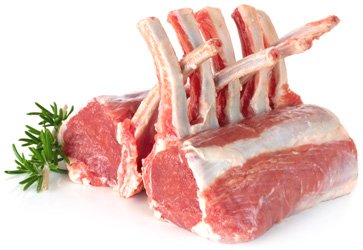
Mutton is the meat of sheep, rams. The most valuable meat is the meat of young (up to 18 months) castrated rams or sheep that are unsuitable for breeding.
The meat of well-fed sheep, no older than 3 years, is also tasty. It is distinguished by a light red hue, the fat is elastic and white. The meat of old or poorly fed sheep has a dark red tint and yellow fat. This meat is stringy, and therefore it is best consumed in the form of minced meat.. Favorite meat of the peoples of the East
The fat content in lamb is 2 - 3 times less than in pork.
The advantage of this type of meat is that lamb fat contains 2.5 times less cholesterol than beef fat and 4 times less cholesterol than pork fat.
Calorie content of lamb
The calorie content of boiled lamb is 291 kcal per 100 g. In 100 g of stewed lamb there are 268 kcal, and the calorie content of fried lamb is 320 kcal per 100 g. This product is characterized by a fairly high content of proteins and fats and can lead to obesity if consumed in large quantities .
Nutritional value per 100 grams:
| Proteins, g | Fats, gr | Carbohydrates, g | Ash, gr | Water, g | Calorie content, kcal |
| 16,5 | 15,5 | — | 0,8 | 67,5 | 260-320 |
Lamb in diet and sports nutrition
Athletes who adhere to special diets are not prohibited from eating lamb. You should choose lean parts of the carcass, for example, the back part. In addition, it is important to follow the principles of proper nutrition and choose the most appropriate methods of heat treatment of meat.
During the drying period, it is important to consider how the product is prepared. Even the most dietary meat, fried in a large amount of oil, will not achieve good results in losing weight. Therefore, it is better to eat meat boiled or baked. This product contains the fewest calories, and the nutrients are preserved. This way you can get the required dose of essential nutrients and not gain extra pounds. It is also necessary to take into account the amount of food eaten. If you eat a lot of lamb, for example, at night, then you definitely cannot avoid extra pounds.
Meat in sports is the most important source of protein, including essential amino acids, which are so necessary for building muscle tissue. Therefore, choosing meat for athletes is an extremely responsible and important matter.
To understand the benefits of lamb for athletes, it is important to understand one important process. The fact is that the more protein consumed, the higher the need for vitamin B6, since it is it that supports protein synthesis. And vitamin B12 ensures the supply of oxygen to the muscles and tones the body. Taking these facts into account, lamb is excellent for all athletes, since its content of B vitamins is quite high.
Advice! Lambs of the first category are suitable for dietary nutrition and for athletes, since they have not yet accumulated too much fat, but they already contain a sufficient amount of useful substances.
But each product has its own disadvantages that should be taken into account. Lamb is no exception.
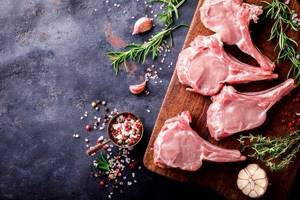
© lily_rocha – stock.adobe.com
Beneficial properties of lamb
Lamb is well suited for feeding the elderly and children. It contains a lot of fluoride, which protects teeth from caries. Lamb fat is low in cholesterol. Moreover, lecithin contained in lamb helps prevent diabetes by stimulating the pancreas, and also has anti-sclerotic properties and normalizes cholesterol metabolism.
Contained potassium, sodium and magnesium salts have a beneficial effect on the heart and blood vessels. Lamb is rich in iron (30% more than in pork), necessary for hematopoiesis, and iodine, which ensures the normal functioning of the thyroid gland.
The taste and nutritional value of lamb is exceptionally high. In terms of protein content, essential amino acids and minerals, it is not inferior to beef, and even exceeds it in calorie content (beef - 1838 kcal/kg, lamb - 2256 kcal/kg). Also because its fat contains a relatively small amount of cholesterol. Some scientists believe that atherosclerosis is less common among peoples who eat mainly lamb.
But you still need to take a break from meat, which is why all major religions of the world provide for fasting. After fasting, when the body has rested from eating meat, we become calmer and smarter. True, it is impossible to completely give up meat food, since our nutrition must be complete and balanced.
Meat broths will benefit people suffering from gastritis with low acidity. But they will have to be completely excluded for those who have a stomach ulcer or gastritis with high acidity. Meat also has an adverse effect on diseased kidneys. After all, any meat contains a lot of toxic substances; in addition, animals are fed antibiotics and hormonal stimulants, and these substances are very destructive to the kidneys and liver.
Burnt lamb meat is useful against the bite of snakes, black and yellow scorpions. With wine it helps against a mad dog bite


